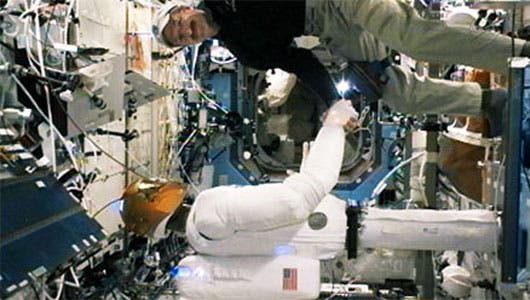The Robonaut 2, an autonomous NASA robot commissioned to ease the lives of astronauts on board the International Space Station by taking over some complex tasks and, also, cure boredom, has finally been booted to move a limb, although he’s been on the station since February 2011 – a whole year. The Robonaut recently went through a checkout of its dextrous limbs and features, after which he greeted the commander of the current ISS missions with a firm hand shake and a message, “Hello, World”, transmitted through hand sign language.
“For the record, it was a firm handshake,” American astronaut Daniel Burbank said in a NASA video marking the event. “Very nice… nice job on the programming and all the engineering. Quite an impressive robot.”

Some motion tests were performed to check if Robonaut’s motors and joints were working properly. The bot was tested infield in 1 g (Earth’s gravity), however in 0 g (space gravity) its behavior is expected to differ and requires calibration. Anyway, the robot fared very well, and no major problems surfaced.
Robonaut 2, is a $2.5 million droid designed to be an autonomous assistant, helping astronauts by performing complex chores to keep the space station running properly. Although it’s limbs and sensors work great, it will still take a while before it will be able to make a meaningful contribution to the crew, not until they’re sure he can handle the most simple of tasks beforehand, at least. Most likely, Robonaut will be assigned to a taskboard where he can press buttons, flip switches, and use tools without risking accidental thruster firings, unexpected decompression or anything stupid.
NASA station officials said the next major tests for Robonaut 2 in space will be to check the robot’s onboard cameras. The head-mounted cameras allow Robonaut 2’s controllers to see what the robot sees and are also used by the robot itself to verify its work, NASA officials said.
source: NASA






